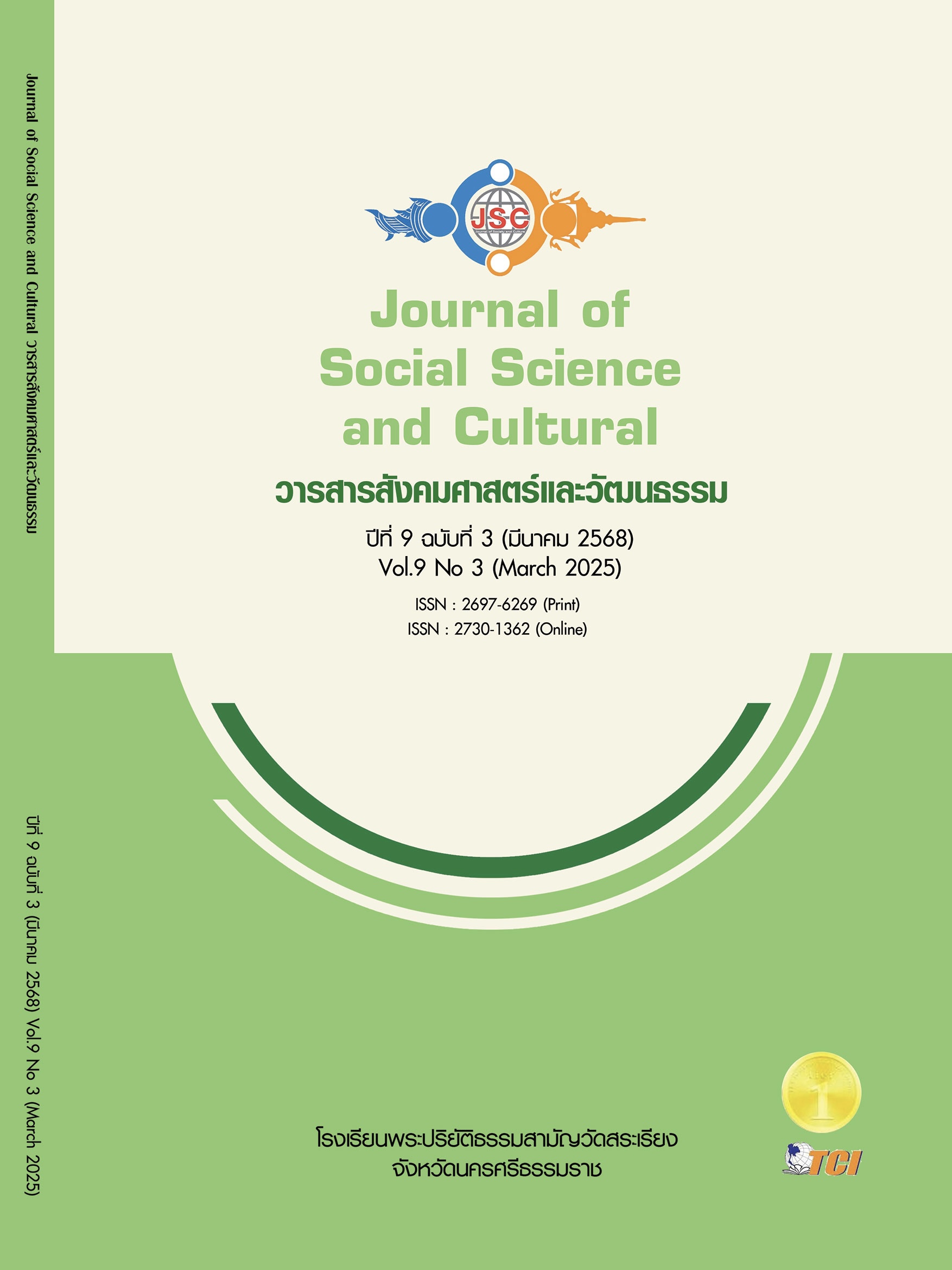MYTH OF CHIFU WANGYE SHRINE SAIBURI DISTRICT, PATTANI PROVINCE: BELIEVES AND ROLES
Main Article Content
Abstract
The purpose of this research is: 1) to study knowledge about legends 2) to analyze the beliefs of the Chifu Wangye Shrine and 3) to analyze the role of the Chifu Wangye Shrine.. This was a qualitative study. Data were collected from 3 main informants: community scholars and experts, people in the community, and tourists, totaling 30 people. The research instrument was an in-depth interview. Data were collected by interviewing together with data from related documents. Data was then analyzed using content analysis. The results of the research found that the Chifu Wangye Shrine, a 106-year-old temple, was built from the belief in the deity Lao Ya Kong of Chinese immigrants who settled in Sai Buri, Pattani during the reign of King Naresuan the Great. It plays a role in the beliefs of devotees in four aspects: 1) Beliefs about health in terms of making sick people recover. 2) Beliefs about family, which are believed to help families live happily and help newborns grow up appropriately. 3) Beliefs in fortune, particularly regarding employment, career advancement, and professional success. 4) belief in resolving bad luck. Chifu Wangye Shrine is another shrine where many people who believe in bad luck travel to perform rituals to resolve bad luck each year. As for the role of Chifu Wangye Shrine, it was found that it has 3 important roles: the role towards individuals in terms of gifts and encouragement for the local community and nearby communities; the role towards the community, where Chifu Wangye Shrine is a sacred place and a place for various rituals related to Thai-Chinese people, demonstrating unity within the community; and the role towards tourism, which can attract tourists to learn about and watch important traditions and rituals that are organized, which can generate a lot of income for people in the community and the shrine.
Article Details
References
ชิว หายเฟิง และธีรโชติ เกิดแก้ว. (2564). ความเชื่อ พิธีกรรม และบทบาทศาลเจ้าหลีตีเมี้ยวของชาวจีนฮากกา เขตป้อมปราบศัตรูพ่าย กรุงเทพมหานคร. ใน วิทยานิพนธ์ศิลปศาสตรมหาบัณฑิต สาขาการสื่อภาษาไทยเป็นภาษาที่สอง. มหาวิทยาลัยหัวเฉียวเฉลิมพระเกียรติ.
ธีรพงศ์ แซ่โค้ว. (2566). คุณูปการ สู่ความศรัทธา “เล่าเอี๊ยะก๋ง” เทพเจ้าเมืองสายบุรี. วารสารรูสมิแล, 44(2), 43-48.
บัญชา เตส่วน. (2566). พิธีแซยิดตี่ฮู้อ่องเอี๋ยและเลี้ยงทหาร “คุณค่าความศรัทธาและความกตัญญู” ศาลเจ้าจ่ายเฮงเกียง ตี่ฮู้อ่องเอี๋ย เล่าเอี้ยกงสายบุรี. วารสารรูสมิแล, 44(2), 19-28.
พุมรี อรรถรัฐเสถียร. (2555). ศาลเจ้าเล่าเอี๊ยะกง ณ เมืองสายบุรี. วารสารรูสมิแล, 33(2), 71-77.
วสันต์ ชีวะสาธน์. (2531). รายงานการวิจัยสถาปัตยกรรมจีนในเมืองปัตตานี. วารสารรูสมิแล, 2(1), 52-57.
สมบูรณ์ สุขสำราญ. (2529). ความเชื่อทางศาสนาและพิธีกรรมของชุมชนจีน. กรุงเทพมหานคร: โครงการเผยแพร่ผลงานวิจัย จุฬาลงกรมหาวิทยาลัย.
อรนรินทร์ และอิมธิรา อ่อนคำ. (2564). ความเชื่อและพิธีกรรมของศาลเจ้าพ่อพระเพลิงในสังคมไทยกรณีศึกษาฝั่งธนบุรี. วารสารภาษาและวัฒนธรรมไทยในวิถีโลกใหม่, 2(1), 457-478.
อรวรรณ สวัสดี. (2559). ศาลเจ้ากับชุมชน: บทบาทของศาลเจ้าที่มีต่อชุมชนบ้านปากน้ำท่าทอง ตำบลท่าทอง อำเภอกาญจนดิษฐ์ จังหวัดสุราษฎร์ธานี. ใน รายงานการวิจัย. มหาวิทยาลัยศิลปากร.
Eisinga, R. et al. (2012). The reliability of a two-item scale: Pearson, Cronbach, or Spearman-Brown? National Library of Medicine, 58(4), 37-42.
Long, G. (2557b). ศาลเจ้าหน่าจาซาไท้จื้อ : ความเชื่อ รูปเคารพ และบทบาท. ใน วิทยานิพนธ์ศิลปศาสตรมหาบัณฑิต สาขาวิชาไทยศึกษา. มหาวิทยาลัยบูรพา.
Long, G. (2557a). ศาลเจ้าหน่าจาซาไท้จื้อ : ความเชื่อ รูปเคารพ และบทบาท. วารสารศิลปศาสตร์ปริทัศน์, 9(17), 62–73.
Su, S. (2562). ความเชื่อและบทบาทของศาลเจ้า: กรณีศึกษา ตลาดน้อยเขตสัมพันธวงศ์ กรุงเทพมหานคร. ใน วิทยานิพนธ์ศิลปศาสตรมหาบัณฑิต สาขาการสื่อภาษาไทยเป็นภาษาที่สอง. มหาวิทยาลัยหัวเฉียวเฉลิมพระเกียรติ.


